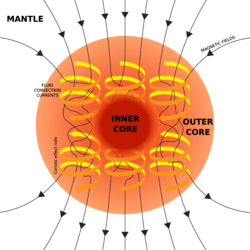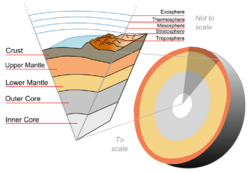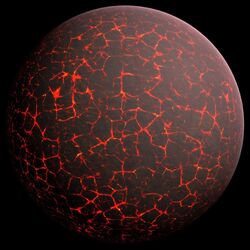Earth:Earth's outer core
Earth's outer core is a fluid layer about 2,260 km (1,400 mi) thick, composed of mostly iron and nickel that lies above Earth's solid inner core and below its mantle.[1][2][3] The outer core begins approximately 2,889 km (1,795 mi) beneath Earth's surface at the core-mantle boundary and ends 5,150 km (3,200 mi) beneath Earth's surface at the inner core boundary.[4]
Properties
The outer core of Earth is liquid, unlike its inner core, which is solid.[5] Evidence for a fluid outer core includes seismology which shows that seismic shear-waves are not transmitted through the outer core.[6] Although having a composition similar to Earth's solid inner core, the outer core remains liquid as there is not enough pressure to keep it in a solid state.
Seismic inversions of body waves and normal modes constrain the radius of the outer core to be 3483 km with an uncertainty of 5 km, while that of the inner core is 1220±10 km.[7]:94
Estimates for the temperature of the outer core are about 3,000–4,500 K (2,700–4,200 °C; 4,900–7,600 °F) in its outer region and 4,000–8,000 K (3,700–7,700 °C; 6,700–14,000 °F) near the inner core.[8] Modeling has shown that the outer core, because of its high temperature, is a low-viscosity fluid that convects turbulently.[8] The dynamo theory sees eddy currents in the nickel-iron fluid of the outer core as the principal source of Earth's magnetic field. The average magnetic field strength in Earth's outer core is estimated to be 2.5 millitesla, 50 times stronger than the magnetic field at the surface.[9][10]
As Earth's core cools, the liquid at the inner core boundary freezes, causing the solid inner core to grow at the expense of the outer core, at an estimated rate of 1 mm per year. This is approximately 80,000 tonnes of iron per second.[11]
Light elements of Earth's outer core
Composition
Earth's outer core cannot be entirely constituted of iron or iron-nickel alloy because their densities are higher than geophysical measurements of the density of Earth's outer core.[12][13][14][15] In fact, Earth's outer core is approximately 5 to 10 percent lower density than iron at Earth's core temperatures and pressures.[15][16][17] Hence it has been proposed that light elements with low atomic numbers compose part of Earth's outer core, as the only feasible way to lower its density.[14][15][16] Although Earth's outer core is inaccessible to direct sampling,[14][15][18] the composition of light elements can be meaningfully constrained by high-pressure experiments, calculations based on seismic measurements, models of Earth's accretion, and carbonaceous chondrite meteorite comparisons with bulk silicate Earth (BSE).[12][14][15][16][18][19] Recent estimates are that Earth's outer core is composed of iron along with 0 to 0.26 percent hydrogen, 0.2 percent carbon, 0.8 to 5.3 percent oxygen, 0 to 4.0 percent silicon, 1.7 percent sulfur, and 5 percent nickel by weight, and the temperature of the core-mantle boundary and the inner core boundary ranges from 4,137 to 4,300 K and from 5,400 to 6,300 K respectively.[14]
Constraints
Accretion
The variety of light elements present in Earth's outer core is constrained in part by Earth's accretion.[16] Namely, the light elements contained must have been abundant during Earth's formation, must be able to partition into liquid iron at low pressures, and must not volatilize and escape during Earth's accretionary process.[14][16]
CI chondrites
CI chondritic meteorites are believed to contain the same planet-forming elements in the same proportions as in the early Solar System,[14] so differences between CI meteorites and BSE can provide insights into the light element composition of Earth's outer core.[20][14] For instance, the depletion of silicon in BSE compared to CI meteorites may indicate that silicon was absorbed into Earth's core; however, a wide range of silicon concentrations in Earth's outer and inner core is still possible.[14][21][22]
Implications for Earth's accretion and core formation history
Tighter constraints on the concentrations of light elements in Earth's outer core would provide a better understanding of Earth's accretion and core formation history.[14][19][23]
Consequences for Earth's accretion
Models of Earth's accretion could be better tested if we had better constraints on light element concentrations in Earth's outer core.[14][23] For example, accretionary models based on core-mantle element partitioning tend to support proto-Earths constructed from reduced, condensed, and volatile-free material,[14][19][23] despite the possibility that oxidized material from the outer Solar System was accreted towards the conclusion of Earth's accretion.[14][19] If we could better constrain the concentrations of hydrogen, oxygen, and silicon in Earth's outer core, models of Earth's accretion that match these concentrations would presumably better constrain Earth’s formation.[14]
Consequences for Earth's core formation
The depletion of siderophile elements in Earth's mantle compared to chondritic meteorites is attributed to metal-silicate reactions during formation of Earth's core.[24] These reactions are dependent on oxygen, silicon, and sulfur,[14][25][24] so better constraints on concentrations of these elements in Earth's outer core will help elucidate the conditions of formation of Earth's core.[14][23][25][24][26]
In another example, the possible presence of hydrogen in Earth's outer core suggests that the accretion of Earth’s water[14][27][28] was not limited to the final stages of Earth's accretion[23] and that water may have been absorbed into core-forming metals through a hydrous magma ocean.[14][29]
Implications for Earth's magnetic field

Earth's magnetic field is driven by thermal convection and also by chemical convection, the exclusion of light elements from the inner core, which float upward within the fluid outer core while denser elements sink.[17][30] This chemical convection releases gravitational energy that is then available to power the geodynamo that produces Earth's magnetic field.[30] Carnot efficiencies with large uncertainties suggest that compositional and thermal convection contribute about 80 percent and 20 percent respectively to the power of Earth's geodynamo.[30] Traditionally it was thought that prior to the formation of Earth's inner core, Earth's geodynamo was mainly driven by thermal convection.[30] However, recent claims that the thermal conductivity of iron at core temperatures and pressures is much higher than previously thought imply that core cooling was largely by conduction not convection, limiting the ability of thermal convection to drive the geodynamo.[14][17] This conundrum is known as the new "core paradox."[14][17] An alternative process that could have sustained Earth's geodynamo requires Earth's core to have initially been hot enough to dissolve oxygen, magnesium, silicon, and other light elements.[17] As the Earth's core began to cool, it would become supersaturated in these light elements that would then precipitate into the lower mantle forming oxides leading to a different variant of chemical convection.[14][17]
References
- ↑ "Earth's Interior". National Geographic. 18 January 2017. https://www.nationalgeographic.com/science/earth/surface-of-the-earth/earths-interior/.
- ↑ Sue, Caryl (2015-08-17). "Core". in Evers, Jeannie (in en). https://education.nationalgeographic.org/resource/core/.
- ↑ Zhang, Youjun; Sekine, Toshimori; He, Hongliang; Yu, Yin; Liu, Fusheng; Zhang, Mingjian (2014-07-15). "Shock compression of Fe-Ni-Si system to 280 GPa: Implications for the composition of the Earth's outer core". Geophysical Research Letters 41 (13): 4554–4559. doi:10.1002/2014gl060670. ISSN 0094-8276. Bibcode: 2014GeoRL..41.4554Z.
- ↑ Young, C J; Lay, T (1987). "The Core-Mantle Boundary" (in en). Annual Review of Earth and Planetary Sciences 15 (1): 25–46. doi:10.1146/annurev.ea.15.050187.000325. ISSN 0084-6597. Bibcode: 1987AREPS..15...25Y. https://www.annualreviews.org/doi/10.1146/annurev.ea.15.050187.000325.
- ↑ Gutenberg, Beno (2016). Physics of the Earth's interior. Academic Press. pp. 101–118. ISBN 978-1-4832-8212-1.
- ↑ Jeffreys, Harold (1 June 1926). "The Rigidity of the Earth's Central Core" (in en). Monthly Notices of the Royal Astronomical Society 1: 371–383. doi:10.1111/j.1365-246X.1926.tb05385.x. ISSN 1365-246X. Bibcode: 1926GeoJ....1..371J.
- ↑ Global earth physics a handbook of physical constants (3rd ed.). Washington, DC: American Geophysical Union. 1995. ISBN 9780875908519.
- ↑ 8.0 8.1 De Wijs, Gilles A.; Kresse, Georg; Vočadlo, Lidunka; Dobson, David; Alfè, Dario; Gillan, Michael J.; Price, Geoffrey D. (1998). "The viscosity of liquid iron at the physical conditions of the Earth's core". Nature 392 (6678): 805. doi:10.1038/33905. Bibcode: 1998Natur.392..805D. http://www.homepages.ucl.ac.uk/~ucfbdxa/pubblicazioni/nat.pdf.
- ↑ Staff writer (17 December 2010). "First Measurement Of Magnetic Field Inside Earth's Core" (in en). Science 2.0. http://www.science20.com/news_articles/first_measurement_magnetic_field_inside_earths_core.
- ↑ Buffett, Bruce A. (2010). "Tidal dissipation and the strength of the Earth's internal magnetic field". Nature 468 (7326): 952–4. doi:10.1038/nature09643. PMID 21164483. Bibcode: 2010Natur.468..952B.
- ↑ Wassel, Lauren; Irving, Jessica; Dues, Arwen (2011). "Reconciling the hemispherical structure of Earth's inner core with its super-rotation". Nature Geoscience 4 (4): 264–267. doi:10.1038/ngeo1083. Bibcode: 2011NatGe...4..264W.
- ↑ 12.0 12.1 Birch, Francis (1952). "Elasticity and constitution of the Earth's interior" (in en). Journal of Geophysical Research 57 (2): 227–286. doi:10.1029/JZ057i002p00227. Bibcode: 1952JGR....57..227B. http://doi.wiley.com/10.1029/JZ057i002p00227.
- ↑ Birch, Francis (1964-10-15). "Density and composition of mantle and core" (in en). Journal of Geophysical Research 69 (20): 4377–4388. doi:10.1029/JZ069i020p04377. Bibcode: 1964JGR....69.4377B. http://doi.wiley.com/10.1029/JZ069i020p04377.
- ↑ 14.00 14.01 14.02 14.03 14.04 14.05 14.06 14.07 14.08 14.09 14.10 14.11 14.12 14.13 14.14 14.15 14.16 14.17 14.18 14.19 14.20 Hirose, Kei; Wood, Bernard; Vočadlo, Lidunka (2021). "Light elements in the Earth's core" (in en). Nature Reviews Earth & Environment 2 (9): 645–658. doi:10.1038/s43017-021-00203-6. ISSN 2662-138X. https://www.nature.com/articles/s43017-021-00203-6.
- ↑ 15.0 15.1 15.2 15.3 15.4 Wood, Bernard J.; Walter, Michael J.; Wade, Jonathan (2006). "Accretion of the Earth and segregation of its core" (in en). Nature 441 (7095): 825–833. doi:10.1038/nature04763. ISSN 1476-4687. PMID 16778882. Bibcode: 2006Natur.441..825W. https://www.nature.com/articles/nature04763.
- ↑ 16.0 16.1 16.2 16.3 16.4 Poirier, Jean-Paul (1994-09-01). "Light elements in the Earth's outer core: A critical review" (in en). Physics of the Earth and Planetary Interiors 85 (3): 319–337. doi:10.1016/0031-9201(94)90120-1. ISSN 0031-9201. Bibcode: 1994PEPI...85..319P. https://dx.doi.org/10.1016/0031-9201%2894%2990120-1.
- ↑ 17.0 17.1 17.2 17.3 17.4 17.5 Mittal, Tushar; Knezek, Nicholas; Arveson, Sarah M.; McGuire, Chris P.; Williams, Curtis D.; Jones, Timothy D.; Li, Jie (2020-02-15). "Precipitation of multiple light elements to power Earth's early dynamo" (in en). Earth and Planetary Science Letters 532: 116030. doi:10.1016/j.epsl.2019.116030. ISSN 0012-821X. Bibcode: 2020E&PSL.53216030M.
- ↑ 18.0 18.1 Zhang, Youjun; Sekine, Toshimori; He, Hongliang; Yu, Yin; Liu, Fusheng; Zhang, Mingjian (2016-03-02). "Experimental constraints on light elements in the Earth's outer core" (in en). Scientific Reports 6 (1): 22473. doi:10.1038/srep22473. ISSN 2045-2322. PMID 26932596. Bibcode: 2016NatSR...622473Z.
- ↑ 19.0 19.1 19.2 19.3 Suer, Terry-Ann; Siebert, Julien; Remusat, Laurent; Menguy, Nicolas; Fiquet, Guillaume (2017-07-01). "A sulfur-poor terrestrial core inferred from metal–silicate partitioning experiments" (in en). Earth and Planetary Science Letters 469: 84–97. doi:10.1016/j.epsl.2017.04.016. ISSN 0012-821X. Bibcode: 2017E&PSL.469...84S. https://www.sciencedirect.com/science/article/pii/S0012821X17301954.
- ↑ Zhang, Youjun; Sekine, Toshimori; He, Hongliang; Yu, Yin; Liu, Fusheng; Zhang, Mingjian (2014-07-15). "Shock compression of Fe-Ni-Si system to 280 GPa: Implications for the composition of the Earth's outer core". Geophysical Research Letters 41 (13): 4554–4559. doi:10.1002/2014gl060670. ISSN 0094-8276. Bibcode: 2014GeoRL..41.4554Z.
- ↑ Georg, R. Bastian; Halliday, Alex N.; Schauble, Edwin A.; Reynolds, Ben C. (2007). "Silicon in the Earth's core" (in en). Nature 447 (7148): 1102–1106. doi:10.1038/nature05927. ISSN 1476-4687. PMID 17597757. Bibcode: 2007Natur.447.1102G. https://www.nature.com/articles/nature05927.
- ↑ Dauphas, Nicolas; Poitrasson, Franck; Burkhardt, Christoph; Kobayashi, Hiroshi; Kurosawa, Kosuke (2015-10-01). "Planetary and meteoritic Mg/Si and δ30Si variations inherited from solar nebula chemistry" (in en). Earth and Planetary Science Letters 427: 236–248. doi:10.1016/j.epsl.2015.07.008. ISSN 0012-821X. Bibcode: 2015E&PSL.427..236D. https://www.sciencedirect.com/science/article/pii/S0012821X15004355.
- ↑ 23.0 23.1 23.2 23.3 23.4 Rubie, D. C.; Jacobson, S. A.; Morbidelli, A.; O’Brien, D. P.; Young, E. D.; de Vries, J.; Nimmo, F.; Palme, H. et al. (2015-03-01). "Accretion and differentiation of the terrestrial planets with implications for the compositions of early-formed Solar System bodies and accretion of water" (in en). Icarus 248: 89–108. doi:10.1016/j.icarus.2014.10.015. ISSN 0019-1035. Bibcode: 2015Icar..248...89R. https://www.sciencedirect.com/science/article/pii/S0019103514005545.
- ↑ 24.0 24.1 24.2 Badro, James; Brodholt, John P.; Piet, Hélène; Siebert, Julien; Ryerson, Frederick J. (2015-10-06). "Core formation and core composition from coupled geochemical and geophysical constraints" (in en). Proceedings of the National Academy of Sciences 112 (40): 12310–12314. doi:10.1073/pnas.1505672112. ISSN 0027-8424. PMID 26392555. Bibcode: 2015PNAS..11212310B.
- ↑ 25.0 25.1 Fischer, Rebecca A.; Nakajima, Yoichi; Campbell, Andrew J.; Frost, Daniel J.; Harries, Dennis; Langenhorst, Falko; Miyajima, Nobuyoshi; Pollok, Kilian et al. (2015-10-15). "High pressure metal–silicate partitioning of Ni, Co, V, Cr, Si, and O" (in en). Geochimica et Cosmochimica Acta 167: 177–194. doi:10.1016/j.gca.2015.06.026. ISSN 0016-7037. Bibcode: 2015GeCoA.167..177F.
- ↑ Wade, J.; Wood, B. J. (2005-07-30). "Core formation and the oxidation state of the Earth" (in en). Earth and Planetary Science Letters 236 (1): 78–95. doi:10.1016/j.epsl.2005.05.017. ISSN 0012-821X. Bibcode: 2005E&PSL.236...78W. https://www.sciencedirect.com/science/article/pii/S0012821X05003286.
- ↑ Sato, Takao; Okuzumi, Satoshi; Ida, Shigeru (2016-05-01). "On the water delivery to terrestrial embryos by ice pebble accretion" (in en). Astronomy & Astrophysics 589: A15. doi:10.1051/0004-6361/201527069. ISSN 0004-6361. Bibcode: 2016A&A...589A..15S. https://www.aanda.org/articles/aa/abs/2016/05/aa27069-15/aa27069-15.html.
- ↑ Raymond, Sean N.; Quinn, Thomas; Lunine, Jonathan I. (2007-02-01). "High-Resolution Simulations of The Final Assembly of Earth-Like Planets. 2. Water Delivery And Planetary Habitability". Astrobiology 7 (1): 66–84. doi:10.1089/ast.2006.06-0126. ISSN 1531-1074. PMID 17407404. Bibcode: 2007AsBio...7...66R. https://www.liebertpub.com/doi/10.1089/ast.2006.06-0126.
- ↑ Tagawa, Shoh; Sakamoto, Naoya; Hirose, Kei; Yokoo, Shunpei; Hernlund, John; Ohishi, Yasuo; Yurimoto, Hisayoshi (2021-05-11). "Experimental evidence for hydrogen incorporation into Earth's core" (in en). Nature Communications 12 (1): 2588. doi:10.1038/s41467-021-22035-0. ISSN 2041-1723. PMID 33976113. Bibcode: 2021NatCo..12.2588T.
- ↑ 30.0 30.1 30.2 30.3 Buffett, Bruce A. (2000-06-16). "Earth's Core and the Geodynamo" (in EN). Science 288 (5473): 2007–2012. doi:10.1126/science.288.5473.2007. PMID 10856207. Bibcode: 2000Sci...288.2007B. https://www.science.org/doi/abs/10.1126/science.288.5473.2007.
External links
 |




